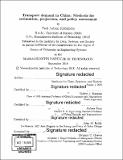| dc.contributor.advisor | Valerie J. Karplus. | en_US |
| dc.contributor.author | Kishimoto, Paul Natsuo | en_US |
| dc.contributor.other | Massachusetts Institute of Technology. Institute for Data, Systems, and Society. | en_US |
| dc.coverage.spatial | a-cc--- | en_US |
| dc.date.accessioned | 2019-03-01T19:56:22Z | |
| dc.date.available | 2019-03-01T19:56:22Z | |
| dc.date.copyright | 2018 | en_US |
| dc.date.issued | 2018 | en_US |
| dc.identifier.uri | http://hdl.handle.net/1721.1/120664 | |
| dc.description | Thesis: Ph. D. in Engineering Systems, Massachusetts Institute of Technology, School of Engineering, Institute for Data, Systems, and Society, 2018. | en_US |
| dc.description | Cataloged from PDF version of thesis. "Some pages in the original document contain text that runs off the edge of the page"--Disclaimer Notice page. | en_US |
| dc.description | Includes bibliographical references. | en_US |
| dc.description.abstract | China's rapid economic growth in the twenty-first century has driven, and been driven by, concomitant motorization and growth of passenger and freight mobility, leading to greater energy demand and environmental impacts. In this dissertation I develop methods to characterize the evolution of passenger transport demand in a rapidly-developing country, in order to support projection and policy assessment. In Essay #1, I study the role that vehicle tailpipe and fuel quality standards ("emissions standards") can play vis-à-vis economy-wide carbon pricing in reducing emissions of pollutants that lead to poor air quality. I extend a global, computable general equilibrium (CGE) model resolving 30 Chinese provinces by separating freight and passenger transport subsectors, road and non-road modes, and household-owned vehicles; and then linking energy demand in these subsectors to a province-level inventory of primary pollutant emissions and future policy targets. While climate policy yields an air quality co-benefit by inducing shifts away from dirtier fuels, this effect is weak within the transport sector. Current emissions standards can drastically reduce transportation emissions, but their overall impact is limited by transport's share in total emissions, which varies across provinces. I conclude that the two categories of measures examined are complementary, and the effectiveness of emissions standards relies on enforcement in removing older, higher-polluting vehicles from the roads. In Essay #2, I characterize Chinese households' demand for transport by estimating the recently-developed, Exact affine Stone index (EASI) demand system on publicly-available data from non-governmental, social surveys. Flexible, EASI demands are particularly useful in China's rapidly-changing economy and transport system, because they capture ways that income elasticities of demand, and household transport budgets, vary with incomes; with population and road network densities; and with the supply of alternative transport modes. I find transport demand to be highly elastic ([epsilon][subscript x] = 1.46) at low incomes, and that income-elasticity of demand declines but remains greater than unity as incomes rise, so that the share of transport in households' spending rises monotonically from 1.6 % to 7.5 %; a wider, yet lower range than in some previous estimates. While no strong effects of city-level factors are identified, these and other non-income effects account for a larger portion of budget share changes than rising incomes. Finally, in Essay #3, I evaluate the predictive performance of the EASI demand system, by testing the sensitivity of model fit to the data available for estimation, in comparison with the less flexible, but widely used, Almost Ideal demand system (AIDS). In rapidly-evolving countries such as China, survey data without nationwide coverage can be used to characterize transport systems, but the omission of cities and provinces could bias results. To examine this possibility, I estimate demand systems on data subsets and test their predictions against observations for the withheld fraction. I find that simple EASI specifications slightly outperform AIDS under cross-validation; these offer a ready replacement in standalone and CGE applications. However, a trade-off exists between accuracy and the inclusion of policy-relevant covariates when data omit areas with high values of these variables. Also, while province-level fixed-effects control for unobserved heterogeneity across units that may bias parameter estimates, they increase prediction error in out-of-sample applications-revealing that the influence of local conditions on household transport expenditure varies significantly across China's provinces. The results motivate targeted transport data collection that better spans variation on city types and attributes; and the validation technique aids transport modelers in designing and validating demand specifications for projection and assessment. | en_US |
| dc.description.statementofresponsibility | by Paul Natsuo Kishimoto. | en_US |
| dc.format.extent | 241 pages | en_US |
| dc.language.iso | eng | en_US |
| dc.publisher | Massachusetts Institute of Technology | en_US |
| dc.rights | MIT theses are protected by copyright. They may be viewed, downloaded, or printed from this source but further reproduction or distribution in any format is prohibited without written permission. | en_US |
| dc.rights.uri | http://dspace.mit.edu/handle/1721.1/7582 | en_US |
| dc.subject | Institute for Data, Systems, and Society. | en_US |
| dc.title | Transport demand in China : estimation, projection, and policy assessment | en_US |
| dc.type | Thesis | en_US |
| dc.description.degree | Ph. D. in Engineering Systems | en_US |
| dc.contributor.department | Massachusetts Institute of Technology. Engineering Systems Division | |
| dc.contributor.department | Massachusetts Institute of Technology. Institute for Data, Systems, and Society | |
| dc.identifier.oclc | 1088439244 | en_US |
